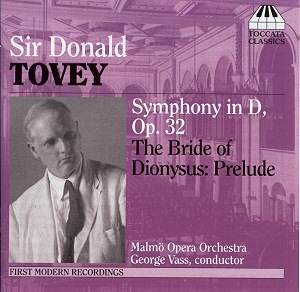Donald Francis Tovey
– a name I first came across at the
age of about 14 when trying to learn
some of the easier Beethoven Piano Sonatas
from the Associated Board Edition. Subsequently
the complete set was acquired as a present
and a search of a sheet music database
indicates that it is still available.
Harold Craxton edited the works and
Tovey provided quite detailed commentaries
in 1931.
Until this disc arrived
for review, I knew almost nothing about
man and had not knowingly heard his
music before. Since I may not be alone
in that respect, it is useful that the
disc comes with excellent notes on both
the man and the music. These are by
Peter Shore, a distant relative of the
composer who was also the recording
producer. To me the picture on the front
makes Tovey look like a surgeon on a
ward round but in fact he was Professor
of Music at Edinburgh from 1914 until
his death. For an academic, he seems
to have lived quite an interesting life,
notably in respect of his relationship
with Miss Sophie Weisse who taught him
the piano from the age of five and was
still trying to influence his personal
life 45 years later!
Judging from the synopsis
in the booklet, Tovey was not a prolific
composer – indeed he clearly spent much
time performing, as a pianist and conducting
the Reid Orchestra in Edinburgh which
he founded in 1917. His most creative
period seems to span the first twenty
years of the century. The composition
of his three-act music drama The
Bride of Dionysus occupied around
eleven years during that period. It
was performed in 1929 and 1932 and,
presumably, has not been heard since.
The prelude is brief and at a moderate
tempo in the mould of Humperdinck’s
prelude to Hänsel und Gretel
- which dates from 1893.
This is the second
recording of Tovey’s Symphony in D.
A 1937 BBC broadcast during which he
conducted the Reid Orchestra has recently
been issued on Symposium and seems to
be currently available from Amazon.com.
Musically the work is very much derived
from Germanic rather than British roots
– the liner suggests Brahms and Bruckner.
It also claims cousinship with Elgar’s
two symphonies which were hot off the
press at the time; I didn’t find much
supporting aural evidence for that.
It has the breadth of a Bruckner symphony,
at least in terms of movement timings
(18, 13, 13 and 14 minutes) but most
reminded me of the Viennese composer
Franz Schmidt. In particular his 3rd
symphony sprang to mind and, interestingly,
that was written 15 years later
as part of a competition to commemorate
the centenary of Schubert’s death. This
work was first performed in Aachen,
Germany late in 1913 under the baton
of Fritz Busch.
The first movement
opens pastorally. It was originally
marked Allegro but Tovey added
maestoso when making some minor
adjustments to the scoring in 1924 -
certainly it is more the latter as performed
here. The booklet has quite detailed
notes on each movement and makes much
of Tovey’s use of remote keys. The interesting
thing is that they don’t sound it, and
the overall effect is one of seamlessness.
The Scherzo is based on the structure
of Beethoven’s Seventh with a recurring
trio and lasts for slightly longer than
the slow movement, an Adagio
to which Tovey added the inscription
Canzona Dorica in 1924. This
is atmospheric and perhaps the most
original part of the work. The finale
is more energetic than the opener but
only just and remains rather stealthful,
perhaps conductor George Vass is a little
too slow here?
Overall, Vass seems
convinced by the work and secures committed
orchestral playing from the Malmö
Opera Orchestra. The recording is good
too and Tovey’s cause is well served.
Perhaps, ultimately, he may be remembered
for some of his compositions as well
as musicology and guidance to pianists.
Patrick C Waller
Background
Peter Shore’s article about the making
of this recording: http://www.musicweb-international.com/classrev/2005/June05/Tovey_symphony_Shore.htm
see also Review
by Rob Barnett
